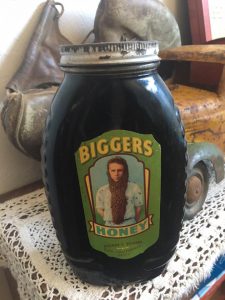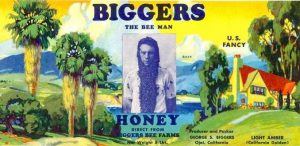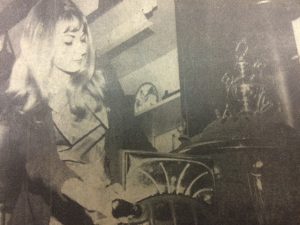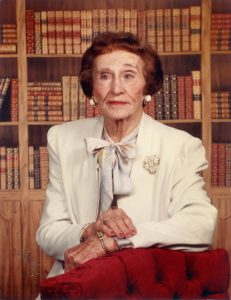The following article first appeared in the Wednesday, June 5, 1968 edition of “The Ojai Valley News and Oaks Gazette” on Page D-1. That newspaper is now the “Ojai Valley News”. The article is reprinted here with their permission. Effie Skelton is the author. Photos have been inserted into this article by the “Ojai Valley Museum”.
BIGGERS THE BEE MAN
What’s Doin’ in Meiners
by
Effie Skelton
Meiners Oaks continued to expand. On February 15, 1961, another subdivision was added by Griffin and Son, Inc., consisting of seventy two lots, on South Rice Road. Soon the homes were built and filled with new residents.
On January 2, 1946, Mr. and Mrs. J. B. (Josh) Smith, 221 South Poli Street, arrived from Wichita, Kansas, to visit their friends, the Edward Sorensens, who had recently move here from Wichita. They prevailed upon the Smiths to make this their home. At that time, there were many homes being built and carpenter work was plentiful. Smith purchased three lots and started his home.
Now, they have a well-cared-for neat home, fenced, with grounds that are attractively landscaped. There is hardly room in which to put a single plant; for they have fruit trees, bouganvilla, hibiscus, fuchsias, bottle brush, palm trees and Monterey pines. Any corner of their garden would make a lovely picture.
Smith helped build many homes in Ojai Valley. He is now retired. Their hobby is keeping their home in excellent condition, and they are an example of what two people may do to improve their home and make it an asset to the community.
Mr. and Mrs. George Biggers moved to 223 South Padre Juan in 1938, a couple that have not only raised their own large family, but helped other children. They have lived in a house by the side of the road and been a friend of man, of bees, of agriculture and of nature. Biggers is also pastor of the friendly Church of Christ on the corner of Padre Juan and El Roblar.
Biggers experiences with bees have been written up in newspapers and magazines, large and small. He is a man who collects experiences in life as many others may collect pretty rocks. He works with millionaires and the poor, the industrialist and the worker, the sick and the well, and as in Kiplings poem “If”, he has not lost the common touch.
Biggers was born in Oakland, his father moved to San Francisco soon afterwards, where they experienced the 1906 earthquake, and lost everything. His father came near being shot for looting when he was carrying his sewing machine up Nob Hill and was saved by having a picture in machine drawer. The family moved to Monrovia where the father was promotion manager for Fleischman Yeast Company. Then — on to Santa Paula, where he operated a bakery and bought a ranch on Santa Paula Creek, where a cloudburst wiped out their home and possessions.
Biggers became interested in bees at the age of eight, when during a school lunch hour the bees swarmed on an oak limb, he contained them in a burlap sack. His teacher, Iris McIntyre, whose father was a beekeeper, gave him books on bees to read. His high school paper was on bees.
Biggers states that “Mankind can learn valuable lessons from these hard workers. They only stop work to sleep. They have a highly organized society. Duties are assigned to various individuals; there are workers who gather the honey, nurse bees who clean and cool the hive, the guard bees who protect. When bees are on long trips the hives are not forgotten by the bees. To keep the wax from melting and the young bees from dying, the nurse bees are stationed near the frames, fanning them with their wings, some lines fanning in one direction and others in the opposite direction, creating refrigeration rotation. In addition to being wise administrators, the bees are excellent architects. The octagonal cells in their combs are so perfect that scientists found they do not vary in construction from generation to generation. A company supplying needs for operation produced artificial wax combs had the bees looking them over. The bees rejected them, chewed them to bits, and rebuilt them. A California scientist unpuzzled it, the little cells were a fraction of a degree off from being perfect. When built perfectly they accepted them.”

Biggers says that insecticides are wiping out whole colonies of bees, which is creating a danger to American agriculture, as bee pollination is used to increase crops. He moves hives all over California and the western part of the United States. He recently moved 1200 hives to Crowley County, Colorado.



 This lady knew about small beginnings. Born in Oklahoma around the turn of the century, Effie Skelton weighed in at 1 1/2 pounds. Told there was no way this child could survive, the Cherokee Indian auntie assisting at Effie’s birth ignored the doctor’s grim prognosis, wrapped Effie in soft cotton, tucked her into a shoe box which she placed in the warming oven of the wood stove and then every hour fed her a drop or two of blackberry brandy. Effie kicked into high gear and eventually became a driving force in the Ojai.
This lady knew about small beginnings. Born in Oklahoma around the turn of the century, Effie Skelton weighed in at 1 1/2 pounds. Told there was no way this child could survive, the Cherokee Indian auntie assisting at Effie’s birth ignored the doctor’s grim prognosis, wrapped Effie in soft cotton, tucked her into a shoe box which she placed in the warming oven of the wood stove and then every hour fed her a drop or two of blackberry brandy. Effie kicked into high gear and eventually became a driving force in the Ojai.